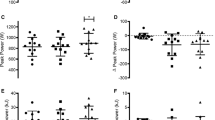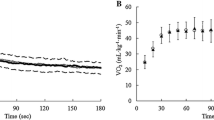Abstract
Taurine can affect the energy system metabolism, specifically the lipid metabolism, since an increase in lipid oxidation may promote carbohydrate savings. We hypothesized that taurine supplementation associated with high-intensity exercise could increase levels of lipolysis, benefiting swimmer performance. Nine male competitive swimmers performed two 400-m front crawl maximal efforts with a 1-week washout, and the athletes received 6 g of taurine (TAU) or placebo (PLA) supplementation 120 min before performing the effort. Oxygen consumption and the contribution of the energy systems were analyzed post effort using a Quark CPET gas analyzer. Blood samples were collected before, and 5 min post the effort for taurine and glycerol analysis. Immediately before and 3, 5, and 7 min post the effort, blood samples from the earlobe were collected to determine lactate levels. An increase of 159% was observed in taurine plasma levels 120 min post ingestion. Glycerol levels were higher in both groups post effort; however, the TAU condition promoted an 8% higher increase than the PLA. No changes were observed in swimmer performance or lactate levels; however, the percentage change in lactate levels (∆[La−]) was different (TAU: 9.36 ± 2.78 mmol L−1; PLA: 11.52 ± 2.19 mmol L−1, p = 0.04). Acute taurine supplementation 120 min before performing a maximal effort did not improve swimmer performance; however, it increased glycerol plasma levels and reduced both the ∆[La−] and lactic anaerobic system contribution.



Similar content being viewed by others
References
American College of Sports Medicine (2016) American Dietetic Association, and Dietitians of Canada. Nutrition and athletic performance. Med Sci Sports Exerc 32:2130–2145
Artioli GG, Bertuzzi RC, Roschel H, Mendes SH, Lancha AH Jr, Franchini E (2012) Determining the contribution of the energy systems during exercise. J Vis Exp 61:e3413. doi:10.3791/3413
Bakker AJ, Berg HM (2002) Effect of taurine on sarcoplasmic reticulum function and force in skinned fast-twitch skeletal muscle fibres of the rat. J Physiol 538(Pt 1):185–194. doi:10.1113/jphysiol.2001.012872
Balshaw TG, Bampouras TM, Barry TJ, Sparks SA (2013) The effect of acute taurine ingestion on 3-km running performance in trained middle-distance runners. Amino Acids 44(2):555–561. doi:10.1007/s00726-012-1372-1
Bertuzzi RC, Franchini E, Ugrinowitsch C, Kokubun E, Lima-Silva AE, Pires FO, Nakamura FY, Kiss MA (2010) Predicting MAOD using only a supramaximal exhaustive test. Int J Sports Med 31(7):477–481. doi:10.1055/s-0030-1253375
Bonne TC, Lundby C, Jørgensen S, Johansen L, Mrgan M, Bech SR, Sander M, Papoti M, Nordsborg NB (2014) “Live High-Train High” increases hemoglobin mass in Olympic swimmers. Eur J Appl Physiol 114(7):1439–1449. doi:10.1007/s00421-014-2863-4
Brisola GM, Miyagi WE, da Silva HS, Zagatto AM (2015) Sodium bicarbonate supplementation improved MAOD but is not correlated with 200- and 400-m running performances: a double-blind, crossover, and placebo-controlled study. Appl Physiol Nutr Metab 40(9):931–937. doi:10.1139/apnm-2015-0036
Carneiro EM, Latorraca MQ, Araujo E, Beltrá M, Oliveras MJ, Navarro M, Berná G, Bedoya FJ, Velloso LA, Soria B, Martín F (2009) Taurine supplementation modulates glucose homeostasis and islet function. J Nutr Biochem 20(7):503–511. doi:10.1016/j.jnutbio.2008.05.008
Carter SL, Rennie C, Tarnopolsky MA (2001) Substrate utilization during endurance exercise in men and women after endurance training. Am J Physiol Endocrinol Metab 280(6):E898–E907
Cuisinier C, Ward RJ, Francaux M, Sturbois X, de Witte P (2001) Changes in plasma and urinary taurine and amino acids in runners immediately and 24 h after a marathon. Amino Acids 20(1):13–23
Deyl Z, Hyanek J, Horakova M (1986) Profiling of amino acids in body fluids and tissues by means of liquid chromatography. J Chromatogr 379:177–250
Di Prampero PE, Margaria R (1968) Relationship between O2 consumption, high energy phosphates and the kinetics of the O2 debt in exercise. Pflugers Arch 304(1):11–19
Dutka TL, Lamboley CR, Murphy RM, Lamb GD (2014) Acute effects of taurine on sarcoplasmic reticulum Ca2+ accumulation and contractility in human type I and type II skeletal muscle fibres. J Appl Physiol 117:797–905. doi:10.1152/japplphysiol.00494.2014
Galloway SD, Talanian JL, Shoveller AK, Heigenhauser GJ, Spriet LL (2008) Seven days of oral taurine supplementation does not increase muscle taurine content or alter substrate metabolism during prolonged exercise in humans. J Appl Physiol 105(2):643–651. doi:10.1152/japplphysiol.90525.2008
Ghandforoush-Sattari M, Mashayekhi S, Krishna CV, Thompson JP, Routledge PA (2010) Pharmacokinetics of oral taurine in healthy volunteers. J Amino Acids 2010:346237. doi:10.4061/2010/346237
Hansen SH, Andersen ML, Birkedal H, Cornett C, Wibrand F (2006) The important role of taurine in oxidative metabolism. Adv Exp Med Biol 583:129–135. doi:10.1007/978-0-387-33504-9_13
Imagawa TF, Hirano I, Utsuki K, Horie M, Naka A, Matsumoto K, Imagawa S (2009) Caffeine and taurine enhance endurance performance. Int J Sports Med 30(7):485–488. doi:10.1055/s-0028-1104574
Institute of Medicine (2005) Dietary reference intakes: applications in dietary assessment. Washington DC
Jeukendrup AE (2002) Regulation of fat metabolism in skeletal muscle. Ann N Y Acad Sci 967:217–235. doi:10.1111/j.1749-6632.2002.tb04278.x
Jeukendrup AE, Saris WH, Wagenmakers AJ (1998) Fat metabolism during exercise: a review–part II: regulation of metabolism and the effects of training. Int J Sports Med 19(5):293–302. doi:10.1055/s-2007-971921
Jeukendrup AE, Jentjens RLPG, Moseley L (2005) Nutritional considerations in triathlon. Sports Med 35(2):163–181. doi:10.2165/00007256-200535020-00005
Jurimae J, Haljaste K, Cicchella A, Lätt E, Purge P, Leppik A, Jürimäe T (2007) Analysis of swimming performance from physical, physiological, and biomechanical parameters in young swimmers. Pediatr Exerc Sci 19(1):70–81. doi:10.1123/pes.19.1.70
Kalva-Filho CA, Zagatto AM, Araújo MI, Santiago PR, da Silva AS, Gobatto CA, Papoti M (2015) Relationship between aerobic and anaerobic parameters from 3-minute all-out tethered swimming and 400-m maximal front crawl effort. J Strength Cond Res 29(1):238–245. doi:10.1519/JSC.0000000000000592
Kerksick C, Harvey T, Stout J, Campbell B, Wilborn C, Kreider R, Kalman D, Ziegenfuss T, Lopez H, Landis J, Ivy JL, Antonio J (2008) International Society of Sports Nutrition position stand: nutrient timing. J Int Soc Sports Nutr 5:17. doi:10.1186/1550-2783-5-17
Kim J, Park J, Lim K (2016) Nutrition supplements to stimulate lipolysis: a review in relation to endurance exercise capacity. J Nutr Sci Vitaminol 62(3):141–161. doi:10.3177/jnsv.62.141
Latt E, Jürimäe J, Mäestu J, Purge P, Rämson R, Haljaste K, Keskinen KL, Rodriguez FA, Jürimäe T (2010) Physiological, biomechanical and anthropometrical predictors of sprint swimming performance in adolescent swimmers. J Sports Sci Med 9:398–404
Lee HM, Paik IY, Park TS (2003) Effects of dietary supplementation of taurine, carnitine, or glutamine on endurance performance and fatigue parameters in athletes. Korean J Nutr 36:711–719
Margaria R, Edwards H, Dill DB (1933) The possible mechanisms of contracting and paying the oxygen debt and the role of lactic acid in muscular contraction. Am J Physiol 106:689–715
Maughan RJ, Fallah J, Coyle EF (2010) The effects of fasting on metabolism and performance. Br J Sports Med 44(7):490–494. doi:10.1136/bjsm.2010.072181
Milioni F, Malta Ede S, Rocha LG, Mesquita CA, de Freitas EC, Zagatto AM (2016) Acute administration of high doses of taurine does not substantially improve high-intensity running performance and the effect on maximal accumulated oxygen deficit is unclear. Appl Physiol Nutr Metab 41(5):498–503. doi:10.1139/apnm-2015-0435
Montpetit RR, Léger LA, Lavoie JM, Cazorla G (1981) VO2 peak during free swimming using the backward extrapolation of the O2 recovery curve. Eur J Appl Physiol Occup Physiol 47(4):385–391
Murakami S (2015) Role of taurine in the pathogenesis of obesity. Mol Nutr Food Res 59(7):1353–1363. doi:10.1002/mnfr.201500067
Nakada T, Hida K, Kwee IL (1991) pH-lactate dissociation during anoxic insult: taurine effect. NeuroReport 2(6):325–328
Pitsiladis YP, Smith I, Maughan RJ (1999) Increased fat availability enhances the capacity of trained individuals to perform prolonged exercise. Med Sci Sports Exerc 31(11):1570–1579. doi:10.1097/00005768-199911000-00012
Ramila KC, Jong CJ, Pastukh V, Ito T, Azuma J, Schaffer SW (2015) Role of protein phosphorylation in excitation-contraction coupling in taurine deficient hearts. Am J Physiol Heart Circ Physiol 308:H232–H239. doi:10.1152/ajpheart.00497.2014
Rutherford JA, Spriet LL, Stellingwerff T (2010) The effect of acute taurine ingestion on endurance performance and metabolism in well-trained cyclists. Int J Sport Nutr Exerc Metab 20(4):322–329
Saponaro C, Gaggini M, Carli F, Gastaldelli A (2015) The subtle balance between lipolysis and lipogenesis: a critical point in metabolic homeostasis. Nutrients 7(11):9453–9474. doi:10.3390/nu7115475
Schaffer SW, Jong CJ, Ramila KC, Azuma J (2010) Physiological roles of taurine in heart and muscle. J Biomed Sci 17(Suppl 1):S2. doi:10.1186/1423-0127-17-S1-S2
Schaffer SW, Shimada-Takaura K, Jong CJ, Ito T, Takahashi K (2016) Impaired energy metabolism of the taurine deficient heart. Amino Acids 48(2):549–558. doi:10.1007/s00726-015-2110-2
Spriet LL, Whitfield J (2015) Taurine and skeletal muscle function. Curr Opin Clin Nutr Metab Care 18(1):96–101. doi:10.1097/MCO.0000000000000135
Termin B, Pendergast DR (2001) Training using the stroke frequency-velocity relationship to combine biomechanical and metabolic paradigms. J Swim Res 14:9–17
Tomlin DL, Wenger HA (2001) The relationship between aerobic fitness and recovery from high intensity intermittent exercise. Sports Med 31(1):1–11. doi:10.2165/00007256-200131010-00001
Tsuboyama-Kasaoka N, Shozawa C, Sano K, Kamei Y, Kasaoka S, Hosokawa Y, Ezaki O (2006) Taurine (2-aminoethanesulfonic acid) deficiency creates a vicious circle promoting obesity. Endocrinol 147(7):3276–3284. doi:10.1210/en.2005-1007
Unnithan V, Holohan J, Fernhall B, Wylegala J, Rowland T, Pendergast DR (2009) Aerobic cost in elite female adolescent swimmers. Int J Sports Med 30(3):194–199. doi:10.1055/s-0028-1104583
VanLoon LJ, Greenhaff PL, Constantin-Teodosiu D, Saris WH, Wagenmakers AJ (2001) The effects of increasing exercise intensity on muscle fuel utilization in humans. J Physiol 536:295–304. doi:10.1111/j.1469-7793.2001.00295.x
Ward R, Francaux M, Cuisinier C, Sturbois X, De Witte P (1999) Changes in plasma taurine levels after different endurance events. Amino Acids 16:71–77
Ward R, Bridge CA, McNaughton LR, Sparks SA (2016) The effect of acute taurine ingestion on 4-km time trial performance in trained cyclists. Amino Acids 48(11):2581–2587. doi:10.1007/s00726-016-2282-4
Zagatto A, Redkva P, Loures J, Kalva Filho C, Franco V, Kaminagakura E, Papoti M (2011) Anaerobic contribution during maximal anaerobic running test: correlation with maximal accumulated oxygen deficit. Scand J Med Sci Sports 21(6):e222–e230. doi:10.1111/j.1600-0838.2010.01258.x
Zamparo P, Capelli C, Pendergast D (2011) Energetics of swimming: a historical perspective. Eur J Appl Physiol 111(3):367–378. doi:10.1007/s00421-010-1433-7
Zhang M, Izumi I, Kagamimori S, Sokejima S, Yamagami T, Liu Z, Qi B (2004) Role of taurine supplementation to prevent exercise-induced oxidative stress in healthy young men. Amino Acids 26(2):203–207. doi:10.1007/s00726-003-0002-3
Author information
Authors and Affiliations
Corresponding author
Ethics declarations
Ethical approval
All procedures performed in studies involving human participants were in accordance with the ethical standards of the institutional and/or national research committee and with the 1964 Helsinki declaration and its later amendments or comparable ethical standards.
Informed consent
Informed consent was obtained from all individual participants included in the study.
Conflict of interest
The authors declare no competing financial interests.
Rights and permissions
About this article
Cite this article
De Carvalho, F.G., Barbieri, R.A., Carvalho, M.B. et al. Taurine supplementation can increase lipolysis and affect the contribution of energy systems during front crawl maximal effort. Amino Acids 50, 189–198 (2018). https://doi.org/10.1007/s00726-017-2505-3
Received:
Accepted:
Published:
Issue Date:
DOI: https://doi.org/10.1007/s00726-017-2505-3




